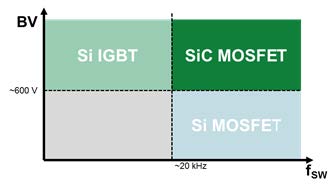
Silicon Carbide (SiC) General Information
Silicon Carbide (SiC), also known as carborundum, is a chemical compound composed of silicon and carbon. Occurring naturally as moissanite, a rare mineral, SiC has been mass produced as a synthetic compound for over 100 years. Silicon Carbide has been used as an abrasive on grinding wheels and to create ceramics for automotive and other applications, including bulletproof vests. For Littelfuse, Silicon Carbide is an interesting compound due to its semiconductor properties.
SiC devices in power electronics feature fast switching times, high blocking voltage capabilities, and the ability to operate at high temperatures. These characteristics, along with recent advancements in manufacturing processes, suggest that Silicon Carbide has the potential to revolutionize power electronics as a successor to traditional silicon-based (Si) devices.
The material properties comparison table below suggests multiple advantages of using SiC instead of Si. In a comparison of SiC and Si semiconductor die with identical structures and dimensions, the SiC die exhibit a lower specific on resistance and a higher breakdown voltage than the Si die.
Note: "4H-SiC" denotes the specific lattice structure of SiC used in Littelfuse Silicon Carbide devices.
Band gap
(eV) |
1.1 |
3.3 |
Breakdown field
(MV/cm) |
0.3 |
3 zu 5 |
Carrier mobility
(cm2/V-s) |
n=1450
p=370
|
n=948
p=99
|
Saturation velocity
(x107 cm/s) |
1.0 |
2.0 |
Thermal conductivity
(W/cm-K) |
1.6 |
3.7 |
Common Silicon Carbide Devices
The most common and popular SiC devices are SiC Schottky Diode Discretes and SiC MOSFETs The SBD structure is advantageous because it eliminates reverse recovery charge. Compared with Si SBDs, SiC SBDs offer lower forward voltage drop and lower on-resistance, which directly improve system efficiency in many converter/inverter applications. SiC SBDs also offer more rugged performance at junction temperatures (TJ) in excess of 150 °C.
Comparing the gate-controlled devices is not quite as straightforward; however, Silicon Carbide does offer a wealth of benefits in certain areas of the operating ranges. The graphic below illustrates two primary operating parameters to consider in power converter applications: operating voltage and switching frequency.

Two of the most common normally-off power transistors are Metal Oxide Semiconductor Field Effect Transistors (MOSFETs) and Integrated Gate Bipolar Transistors (IGBTs). MOSFETs enable fast turn-on and turn-off switching speeds due to their unipolar structure. IGBTs are similar in that they are voltage-controlled devices; however, they incorporate the current-voltage characteristics of Bipolar Junction Transistors (BJTs), which allows them to accommodate higher currents.
Limitations of Traditional Si-based Devices
When you consider the material properties of Si with the characteristics of each device type, the limitations of Si devices become clear. A Si MOSFET is an excellent option for low-voltage applications in which a 650 V rated device or lower is necessary. Si MOSFETs with blocking voltages higher than 650 V, however, exhibit larger on-resistance values. This leads to higher conduction losses. In addition to requiring larger and more complex cooling systems, higher conduction losses mean reduced system efficiency and lower power density.
Si IGBT devices can satisfy higher blocking voltage and low on-resistance requirements. The Si IGBT has long been a key power electronics device due to its high current capabilities; however, it does have severe limitations in maximum achievable switching frequency due to its bipolar nature and the need to sweep out minority carriers during turn-off events, which leads to tail current. Slow switching speeds in IGBTs lead to increased switching losses. This necessitates larger and more complicated cooling systems and reduces efficiency. Additionally the size of the magnetics and filter components in a system scale inversely with operating frequency, thereby limiting power density.
The material properties of Silicon Carbide offer the opportunity to combine high blocking voltage capabilities and low specific on-resistance in a unipolar device, allowing for incredibly fast switching speeds. Innovative SiC MOSFET technology provides a wealth of system-level optimization opportunities for applications design engineers worldwide.
To learn more about the SiC products offered by Littelfuse and how they can help you enhance your next power electronics design, please visit our product pages listed here: